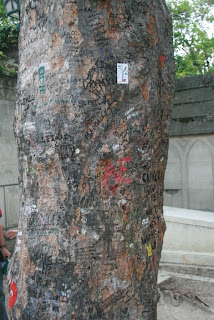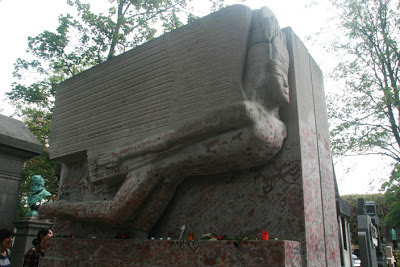If there is anything like a cemetery for the stars, you can't get any more prestigious than Père Lachaise. As I mentioned in Part 1, one of the come-ons to get people to start burying their dead in Père Lachaise was the inclusion of notable celebrities among its inhabitants.
The plan succeeded beyond all expectations. If Hollywood has its Maps to the Stars' Homes, in Père Lachaise, you can buy maps to the stars' graves.
And oh, what a constellation it is. Its resident luminaries - a cross-section of artists, writers, politicians, and other cultural influencers the world over- read like a Vanity Fair Who's Who spanning the centuries. Honoré de Balzac, Sarah Bernhardt, Georges Bizet, Maria Callas, Frédéric Chopin, Colette, Honoré Daumier, Isadora Duncan, Max Ernst, Victor Hugo, Ferdinand de Lesseps, Marcel Marceau, Charles Messier, Modigliani, Yves Montand, Edith Piaf, Marcel Proust, Gertrude Stein and lover Alice B. Toklas, among many others.
But over on the rock-n-roll side, things are a little... different. One of the most famous celebrity graves in Père Lachaise is James Douglas Morrison's. Better known to the world as Jim Morrison, lead singer of the Doors.
Proof that even in death, sharing close quarters with celebrities isn't all it's cracked up to be.
Despite steel barriers impeding (but not quite preventing) people from actually walking up to it, Morrison's grave is littered with shells, cards, letters, flowers, and liquor bottles left by visiting devotees. There used to be a bust of Morrison marking the site, but over the years, people defaced the sculpture until it was finally stolen in 1988.
Other Morrison devotees have taken to writing graffiti on the trees near the gravesite.
In the 1990s, Jim Morrison's father placed a flat stone on the grave, bearing the Greek inscription "KATA TON DAIMONA EAYTOY." Perhaps due to Morrison's ultimately-destructive personal demons, the inscription has been translated as "To each his own daemon." But there are others who believe the real meaning is "true to his own spirit."
----------------
Another famous "resident" of Père Lachaise is the Irish playwright, author, and pundit Oscar Wilde.
Larger-than-life, his grave could only be larger-than-death.
After his incarceration for "the love that dare not speak its name," Wilde immediately fled to Paris, where he later died of meningitis, alone and destitute. Ever the wit, upon being presented with a massive medical bill, he is said to have replied "I am dying as I have lived - beyond my means."
And of course, there are his supposed famous last words. Wilde, a lifelong aesthete and champion of beauty, is said to have risen from his deathbed, looked around at his cheap Parisian hotel room, and then, pointing at the tacky decor, declared that "Either that wallpaper goes, or I do."
Friends put up the money for his plot in Père Lachaise, and young sculptor Jacob Epstein created the massive granite Art Deco angel keeping watch over the grave.
The angel, in true Wilde fashion, has a scandalous little story of its own. Apparently, the sculpture originally came complete with an oversize stone penis, which scandalized Parisian do-goodniks so much that someone broke off the offending appendage sometime in the 60s. This being Paris, unconfirmed rumor also has it that the angel's missing genitals were used for years by the cemetery's director as a paperweight.
Like Jim Morrison's grave, Oscar Wilde's final resting place has also given birth to a tradition: the leaving of kissmarks on the angelo castrato . In the 1990s, public interest in Wilde's tomb grew, attributed to the Hollywood film about his life released in 1997, as well as his death centenary in 2000. The leaving of lipstick marks on the granite monument became an act of devotion to the great and fallen hedonist.
Sadly, Wilde's descendants have recently put a stop to this tradition by cleaning up the statue and installing a 7-foot plate glass wall to prevent any more devotees from planting their kisses and "destroying" the monument.
Yes, even after death, party-poopers still rain on Wilde's parade. So now, we can kiss the tradition goodbye.
Boo! Hiss!














I like to comment a lot ...
ReplyDelete"Moderation is a fatal thing. Nothing succeeds like excess." - Oscar Wilde
DeleteThis comment has been removed by the author.
ReplyDeleteThis comment has been removed by the author.
ReplyDeleteWe are all in the gutter, but some of us are looking at the stars. :)
ReplyDeleteI wonder what your deleted comments were, Joms hehehe.
Deletemultiple postings, Ruddie. :)
Deletenice read. very rich content.
ReplyDeletedon't know both wilde & morrison though..
Thank you.
DeleteYou know Chopin but not Morrison nor Wilde?
there's something inherently romantic, albeit in a gothic manner, about these types of cemeteries, no?
ReplyDeleteAs I said in the first Lachaise post, it's the haunting kind of beauty that's strangely attractive in these rich old cities of the dead.
DeleteThe last photo looks like some Babylonian/Persian/Sumerian sculpture.
ReplyDeleteGood observation, Mr. Green Thumb! Jacob Epstein, the sculptor, actually modeled the angel after Assyrian carvings; hence, the Babylonina/Persian/Sumerian feel.
DeleteMore angel trivia: apparently, when the sculpture was finished, the French were so incensed at the presence of stone genitals that the entire tomb was covered with tarpaulin and even placed under police guard. And it wasn't until World War II that the tomb was freed from its tarp prison, and the granite penis revealed for all to see until someone Bobbittized it in the 60s.
The more you know.
... and shooting stars. LOL Nice article, ruddie.
DeleteHahahah!
DeleteThis comment has been removed by the author.
ReplyDelete